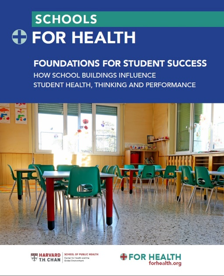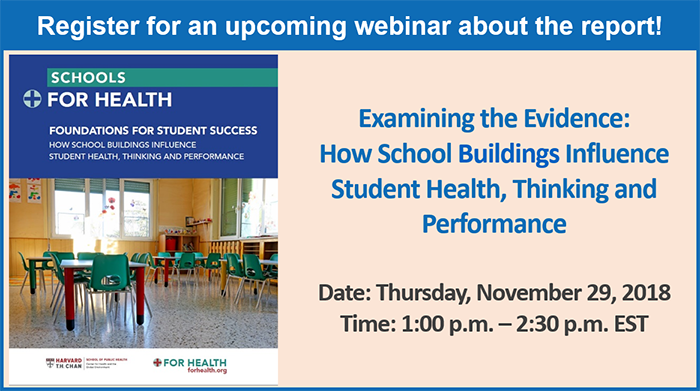|
Heat Impacts Students’ Health, Thinking and Performance
Jose Guillermo Cedeno Laurent and Erika Eitland
Healthy Buildings Program at Harvard T.H. Chan School of Public Health
For more information, check out forhealth.org.
|
School may be in session, but the summer heat is still making us sweat—with school closures from Cleveland to Boston. Built to retain heat in the winter, many northern U.S. schools are 50 years old and lack proper infrastructure and HVAC equipment to cope with high outdoor temperatures. Our southern schools may be more prepared, but long-term use and poorly maintained HVAC systems can negatively impact their ability to respond to high temperatures as well. The need for cooling strategies, such as air conditioning (AC), or school designs that enhance natural ventilation has become more evident due to the increase in frequency and severity of extreme heat events in the past few years. Since 2015, the world has registered the four warmest years on record, and future predictions suggest that this trend will continue in the coming years.
|
 |
Cool Our Schools
Children are more sensitive to the effects of heat compared to adults because they have—
- Higher physical activity levels
- Higher core body temperatures
- Higher metabolic rates
- Larger surface to body mass ratios
- Limited ability to communicate thermal sensations and change their physical environment
- Rapid physiological growth and incomplete development of thermoregulatory function which prevent acclimation to extreme temperatures
These physiological and social differences could result in longer and higher temperature exposures, ultimately increasing children’s chance of experiencing heat stress. School districts have begun to take public health measures by dismissing students early when cooling is not possible. What is the impact of heat stress on students’ physical and cognitive condition?
The Schools for Health team found more than 30 research articles showing that high temperatures influence student health, thinking and performance.
 |
Student Health: High temperatures and humidity have been associated with adverse impacts on physical education by triggering cough and asthma. Warmer classrooms have been associated with worse indoor air quality perceptions and self-reported eye, throat and nose irritation. |
 |
Student Thinking: Heat impacts cognitive function acutely and chronically, including reaction time, information processing, memory and reasoning. A recent study found young adults living in non-air-conditioned dormitories performed worse in two cognitive tests measuring selective attention, reaction time and accuracy. |
 |
Student Performance: High school students in New York state were more likely to fail standardized testing when outdoor temperatures were 90°F or higher. Another study found for each 1°F increase in average temperature throughout the academic year, students without AC experienced a 1 percent deficit in their learning; this effect was tripled among minorities. The good news is that access to AC mitigated up to 78 percent of the observed effects. |
Is air conditioning the solution?
Cooling the air during extreme heat events is a priority to preserve school health. However, AC is not necessarily a “one size fits all” solution. Aging infrastructure limits our ability to retrofit old buildings, increasing energy bills absorb money from tight school budgets, and AC units can sometimes impact other aspects of indoor environments, such as acoustics and indoor air quality.
|
What else can we do to adapt to the heat?
Other behaviors also can help reduce indoor temperatures, such as—
- Limiting the amount of solar thermal heat gains (e.g., using shades to block direct sunlight from heating indoor spaces)
- Being aware of and reducing use of indoor heat sources (e.g., artificial lighting, unnecessary machinery, etc.)
- Limiting outdoor activity during peak temperatures
- Providing clean drinking water to keep students hydrated to mitigate the effects of extreme heat
- Building a green roof or painting roofs white to reduce thermal gain and increase albedo
- Increasing strategic plantings along south-facing windows to provide shade and reduce direct sunlight
- Assessing air vents for potential blockages (e.g., books or plants placed on vent in classrooms) and maintaining internal systems throughout the year to reduce energy use and prevent unintended mold caused by condensation
- Using cool pavement for your school’s parking lot to reduce the urban heat island effect, reflect more solar energy than traditional pavement and enhance water evaporation
|

Spread the word! Forward this email to a colleague. 
Questions?
EPA offers free IAQ Tools for Schools resources—including the School IAQ Assessment Mobile App—to help schools maintain a healthy indoor environment by identifying, correcting and preventing IAQ problems. Learn more about the IAQ Tools for Schools guidance and access other valuable school environmental health resources at www.epa.gov/iaq-schools.
If you have any questions about the IAQ Tools for Schools guidance, please contact the IAQ Tools for Schools Connector Coordinator at iaqschools@epa.gov.
|






